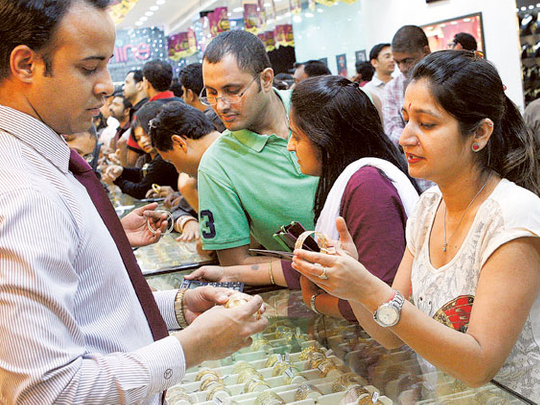
Dubai: It will take a lot to dim gold’s lustre in the UAE’s retail marketplace. All indications point to the 30 days from April 11 to be the best period ever for the local gold and jewellery trade, even surpassing the volumes attained during the recent Dubai Shopping Festival 2013.
With bullion prices trending lower — it dropped to $1,426 (Dh5,237) an ounce in early Asian trading on Monday from Friday’s $1,448 — it was enough of a reason for local buyers to start hitting jewellery shops in the country from early morning on Monday.
And they had one more valid reason to do so. This year’s ‘Akshaya Trithiya’ — one of the most auspicious gold buying days for Indians — was marked on May 13, and gold retailers were putting out all their fine jewellery — and backing them with focused offers — to get buyers interested. In Dubai, gold value started at Dh163.5 a gram, which compares well with the Dh184.75 at last year’s Akshaya Trithiya.
The manic buying between April 11 and April 22 has now been replaced by more stable transaction patterns, with a spike on the day of Akshaya Trithiya.
“After the unchecked run-up in prices for 12 years, current values in the $1,400 an ounce range offer more stability,” said Joy Alukkas, chairman of Joyalukkas Group. “Gold will continue to be a hard currency of choice and what is happening now with the price correction is that it has become slightly more accessible to a wider pool of retail buyers. That’s the biggest plus for the jewellery market here.”
During this phase, average transaction values per shopper have pushed up to Dh4,000-Dh6,000 as against Dh3,000-Dh5,000 earlier.
Sourcing constraints
But there still exists some sourcing constraints. “The scarcity is there on locally made jewellery even after putting in place round-the-clock production,” said Cyriac Varghese, general manager at Sky Jewellery. “It is now that the local market is feeling the pinch of the volume business dropping in recent years which led to many goldsmiths leaving this market.
“The burst of buying in April has fed the scarcity and everyone in the trade is trying to get their hands on sufficient stocks of bullion. It is available… but at a premium.”
According to Tareq Al Mdaka, managing director at Kaloti Jewellery group, the shortage is pronounced in the retail market. “This is due to a refinery capacity shortage in terms of manufacturing smaller bars and ingots to meet demand,” Al Mdaka said. “Kaloti now have production orders for up to 90 days for smaller bars. There is certainly enough supply of physical gold, especially in the larger denominated — 12.5-kilogram and 1-kilogram to a certain extent — gold bars.”
Industry sources, however, do not see any shift in the selling arrangements in what is a tradition-bound industry. “Sourcing and selling arrangements have remained the same and the reason is the market is divided into two: fixed and floating agreements,” said Al Mdaka.
“Fixed is used by institutions, miners and large traders who agree fixed delivery size and pricing no matter what the market conditions are. The latter is used by retailers and small, independent traders who take into account pricing, which results in huge volatility when prices fluctuate as heavily as they did last month.
“Thus, as the current market conditions are extremely volatile, those choosing floating arrangements cannot afford to write an option for a fixed arrangement and are sitting on the sidelines waiting for the price to come off its highs before getting back into the market.”











